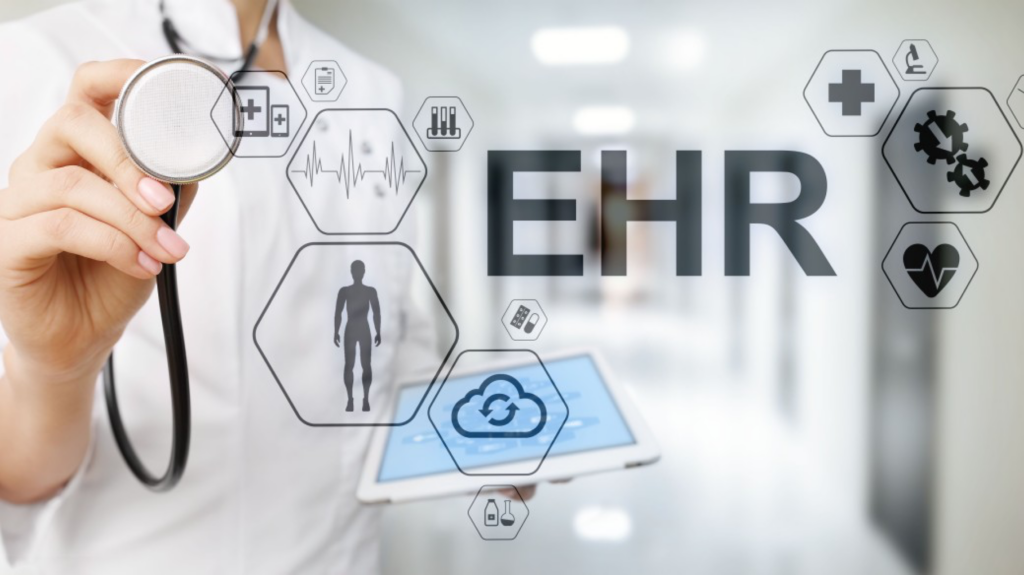Exploring the realm of EHR software development, it’s clear that the industry is booming. Evidence of this surge is evident in headlines such as “At 9.3% CAGR, Global EHR Market Size to hit USD 52.98 Billion by 2027,” and other reports that underscore the rapid expansion of the EHR sector. The promise of EHR software is substantial, with the potential to revolutionize the way patient data is managed, leading to an overall improvement in workflow and patient outcomes.
However, not everyone is sold on the effectiveness of EHRs, with some within the medical field considering EHRs a source of distress. In fact, less than half, only 42 percent, of doctors are happy with their current EHR systems. The industry is calling for more sophisticated, integrated, secure, and high-performing EHR systems, thus challenging EHR software development companies to step up their game.
In light of these demands, the path to creating effective EHR software is not without obstacles. This article is your one-stop-shop guide to EHR software development, discussing its benefits, crucial features, and the potential obstacles you may encounter in this complex field.
How Does EHR Software Solve Clinical Workflow Issues?

The first attempts to develop an EHR go back to the 1960s. Fast forward over 60 years, and EHR software development remains an intensely competitive sector within the healthcare industry. This is primarily due to the great number of benefits they bring to the clinical workflow, including:
- Enhanced organizational and operational efficiency: A modern EHR system reduces staff burden by eliminating the need for paper copies of charts, reports, and bills. Vital information is easily accessible, saving time on paperwork and allowing medical professionals to focus on patient care. EHRs also facilitates seamless interaction between facility departments, enabling instant test result sharing, prescription management.
- Reduced risk of malpractice and clinical errors: EHRs reduce malpractice risks by analyzing data and alerting users about potential issues like adverse reactions and incorrect dosage. Structured patient data helps clinicians identify areas needing attention, monitor closely, and detect recurring mistakes.
- Efficient, secure, and seamless data exchange: Digital records offer enhanced security compared to paper charts by restricting access to sensitive information to authorized personnel. Also, compliant EHR software can minimize the risk of data breaches while facilitating smooth and trouble-free patient information exchange among chosen medical workers.
- Cost optimization: Adopting a modern IT solution in healthcare, such as an EHR system, is an investment that initially requires financial resources. However, the long-term benefits include reduced non-clinical labor costs, such as transcription, physical chart storage, coding, and claims management, resulting in overall resource efficiency.
- Improve Doctor-Patient Communication: EHR implementation is crucial for establishing a patient-centered communication process that benefits both clinicians and patients. It reduces stress by streamlining administrative tasks and encourages patients to actively participate in their healthcare. With EHRs, patients can communicate with physicians, access health records, track progress, and engage in their own care, enhancing the patient experience.
- Overall enhanced patient care: Lastly, the development and adoption of EHR software play a pivotal role in improving healthcare quality. By reducing errors and misunderstandings, streamlining preventive care procedures, facilitating efficient data collection and analysis, enabling well-informed decisions, and offering various other beneficial features, it truly makes a significant impact.
By digitizing and streamlining various aspects of patient care, EHR software is allowing for seamless coordination of care across different healthcare settings. As we move towards the next generation of EHR systems, it is clear that this technology will play a vital role in meeting the stringent data management demands of the healthcare industry.
Must-Have Features For Optimal EHR Software Development

When it comes to EHR software development, it is common for these solutions to vary in their features and customization options based on the unique needs of each healthcare facility. However, there exists a core set of features that form the foundation of any reliable EHR platform. These features are essential for the proper functioning of the electronic health record and should never be disregarded, including:
1. Patient Management Portal
First things first, the EHR development must assist healthcare providers in streamlining their workflow and simplifying administrative tasks such as patient registration, admission, facility transfers, and discharges. This is the core of any effective EHR system.
Besides, this component enables clinicians to gather and track patient interactions, including lab results, diagnoses, medications, and surgical notes, giving care teams the instruments they need to make informed decisions.
A note is that the development team must ensure the EHR software is compatible with various document formats, including industry-specialized ones like DICOM (used in CT and MRI images), but still maintain a clear, intuitive interface.
2. Data Access Management
To comply with healthcare privacy regulations, access to a patient’s medical information should be restricted only to clinical staff, ensuring the highest standards of data protection. This means that adopting a multi-tier access strategy for EHR systems is required to ensure both compliance with HIPAA regulations and efficient role management.
The EHR system should be designed to provide role-based access, which means that different users, such as doctors and nurses, shall only have their duty-required access. To be specific, doctors require distinct levels of visibility compared to administrative staff.
To achieve secure data access management, consider implementing the following tools:
- Unique identifier use
- Encryption standards support
- Automated logoff/session termination
- Multifactor authentification
- Compromised accounts automated blocking
3. E-Prescription
E-prescriptions are another essential feature within EHR software, providing an integrated portal for recording and managing prescription information. This portal stores all data about patient’s treatments, conditions, and relevant health concerns.
Incorporating e-prescriptions in EHR software development is to make patient health information more transparent, therefore helping clinicians make decisions. Prescriptions can be pushed directly to pharmacies or other care team providers, eliminating the need for manual updates and saving clinical workers’ time.
4. Integration with Labs
Smooth integration between EHR software and associated laboratories allows medical professionals to access and review test results faster. Through this feature, doctors can clearly understand any patient’s health status, enabling them to make well-informed decisions.
EHR software development also integrates patients’ medical histories with their present medical processes. As a result, lab specialists can detect the symptoms of a specific condition and send it to healthcare providers via the EHR software.
Note that this feature applies not only to laboratories but also to all external service providers delivering digital medical tests for patients.
5. Billing and Financial Management
Any medical facility must deal with invoices, denials, insurance firms, unpaid claims, and other tedious parts of the administrative job. A successful EHR software can simplify this process by automatically creating invoices when each patient visit is complete, sending out claims to insurance companies, and handling any system constraints.
Also, the billing feature can do much more than just store detailed financial data. The finance team can use these pieces of information to track past revenue, department-level billing, expenses, and possibilities for revenue growth.
Ideal Technology Stack For EHR Software Development

There is no correct answer for the technology stack in EHR software development. When it comes to healthcare solution deployment, every IT firm has its own preferred set of technology.
Check out this rundown of the most widely used technologies in developing EHR software:
- Languages: Python, Swift, C++, Java, Ruby, Kotlin, JavaScript, C#, PHP
- Frameworks & libraries: Django, Angular, React, jQuery, Vue.js, Node.js, Bootstrap, Laravel
- SDKs: iOS, Android, Flutter
- Databases: MySQL, PostgreSQL, Redis, MongoDB
- Web server: Apache, Nginx
- Messaging: RabbitMQ, ActiveMQ, Apache Kafka
- Analytics: Google Analytics, Amazon EMR
- Payment gateway: PayPal, Stripe, Skrill, ACH Payments
- Utilities: Celery, Cloudflare, Amazon S3, Elasticsearch
- Hosting: AWS, Azure, Vultr, GCP
However, there are some more widely adopted technology than others. One of the most popular languages today in healthcare software development is Python, considering both security – as it meets HIPAA requirements – and linguistic diversity.
KMS Healthcare’s Advice:
We recommend utilizing Python for EHR software development. Python continues to reign as one of the most in-demand technologies in 2023 and is nearly ideal for creating healthcare solutions, particularly EHR systems, due to these reasons:
First and foremost, Python fully adheres to the HIPAA medical data safety guidelines while still delivering high-performance levels.
Secondly, Python’s ability to integrate EHR systems with machine learning models and predictive analytics features will enable them to identify increased risk levels of specific patients. In addition, incorporating data science and machine learning with Python-based healthcare applications can also empower faster and more effective image analysis, leading to enhanced diagnostic accuracy.
Remember, these are only recommendations; if you’re not comfortable with any particular programming language or framework, you can always discover a workaround.
Navigating the Common Challenges in EHR Software Development

Developing successful EHR software may appear to be a straightforward journey with a clear-cut process. However, the healthcare industry is filled with burdensome regulations and a fragmented market structure. During the very first step of the EHR software development project, there are several spaces for missteps and costly mistakes that even well-established businesses must encounter, such as:
1. Interoperability Challenges
Although many practices have been done to improve health information exchange and advance interoperability, EHR users always experience difficulties when transferring data to other systems. This creates inconsistent information across multiple sources.
Solution: For new applications, based on US regulations, they likely should be built on more interoperable standards such as HL7 or FHIR. Collaborating with other technology providers can help you navigate connection points with other systems, including other major EHRs, improving data-sharing abilities.
Additionally, it is worth considering utilizing existing connection points. Our KMS team has navigated connections with major EHRs to put together an interoperability platform – CONNECT, boasting a collection of 75+ pre-tested APIs.
KMS CONNECT serves as an exceptional solution for achieving seamless interoperability, offering a robust suite of configurable, pre-tested APIs and an HL7 conversion engine to configure, test, and implement your EHR connections.

2. EHR Adoption Process
Many healthcare providers struggle with EHR software’s complex and unintuitive interfaces, resulting in lower productivity and user dissatisfaction. Often, these systems’ workflows do not align with the existing clinical processes.
Solution: Prioritize custom EHR software development with a user-friendly, intuitive design to reduce these concerns. Providing thorough, ongoing training for all users is also essential to ensure they can efficiently navigate the EHR system. Keeping end-users in the decision-making and implementation process can further help guarantee the software meets their requirements.
3. Securing Patient Information
Electronic health record (EHR) systems store sensitive patient information, making them enticing targets for cybercriminals. Data breaches can lead to severe legal and financial ramifications and damage the organization’s credibility on the market.
Solution: Enforcing robust security protocols, like data encryption, secure user authentication, and frequent security audits from the beginning will significantly help later security control. Also, remember to educate your staff on the best data security practices and keep your software updated with the latest security standards.
4. High Hidden Costs
Developing and deploying EHR software can be much more costly than you would imagine, considering all the hidden expenses for software, hardware, training, and maintenance.
Solution: Cloud-based EHR systems often involve lower initial costs, making them more cost-optimized for small organizations. In addition, using a reliable tool for strategic planning and detailed budgeting can guarantee a long-term revenue flow.

5. Regulation Compliance
Healthcare ranks as one of the most stringently regulated sectors, with regulations affecting various aspects of EHR software, including patient confidentiality, data security, interoperability, and reporting. Navigating through these complicated regulations (such as HIPAA, GDPR, etc.) can prove to be a daunting task, while non-compliance can result in heavy penalties.
Solution: Partnering with EHR software development firms with a proven track record in regulatory compliance and healthcare expertise can be advantageous. These partners have the expertise to guide you on compliance requirements and can support ongoing compliance initiatives to adopt any regulatory modifications. Additionally, providing thorough team training on regulatory requirements can ensure compliant use of the EHR system, further reducing the risk of non-compliance.
We Can Help Develop Compliant, High-Performing EHR Software
The government has put billions into promoting the adoption of EHR, recognizing the revolutionary impact that robust EHR software can have on delivering patient-focused care. And while the EHR system is on its way to forming the backbone of every healthcare organization, some still hesitate to jump into this tech due to the abovementioned obstacles.
The challenges facing EHR software development are, in many cases, systemic. By and large, these can be addressed by partnering with a reliable technology provider with enough industry expertise and development experience to guide you through the complicated process of EHR software development.
With over 14 years of experience in the healthcare industry, our team at KMS Healthcare knows how to help you develop high-performing EHR software that complies with all stringent healthcare regulations and benefits both healthcare providers and patients.
Moreover, what really sets us apart in the healthcare software landscape is our guarantee to deliver top-notch EHR systems tailored to your healthcare organization’s needs, all while ensuring top-level security, scalability, and interoperability. Contact us now to build an EHR solution that truly adds value to your healthcare organization.


